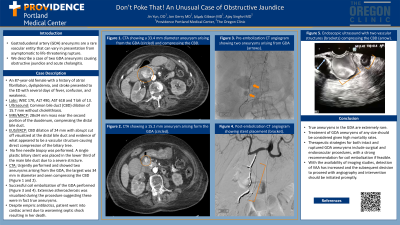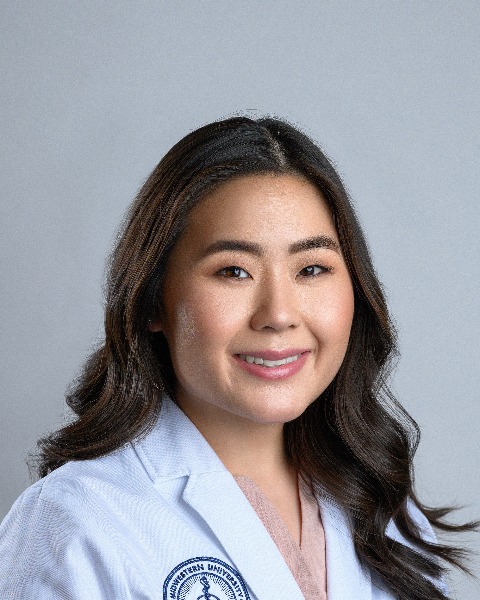Tuesday Poster Session
Category: Biliary/Pancreas
P3558 - Don't Poke That! An Unusual Case of Obstructive Jaundice
Tuesday, October 29, 2024
10:30 AM - 4:00 PM ET
Location: Exhibit Hall E

Has Audio

Jin Yun, DO
Providence Portland Medical Center
Portland, OR
Presenting Author(s)
Jin Yun, DO1, Jon Gerry, MD2, Mark Gibson, MD1, Ajay Singhvi, MD2
1Providence Portland Medical Center, Portland, OR; 2The Oregon Clinic, Portland, OR
Introduction: Visceral artery aneurysms (VAA) are a rare vascular entity that can vary in presentation from asymptomatic to life-threatening rupture. Gastroduodenal artery (GDA) aneurysms are among the rarest forms of VAA, accounting for only 1.5% of reported cases. We describe a case of two GDA aneurysms causing obstructive jaundice and acute cholangitis.
Case Description/Methods: An 87-year-old female with a history of atrial fibrillation, dyslipidemia, and stroke who presented to the emergency department with several days of fever, confusion and weakness. She did not have associated gastrointestinal symptoms and her abdominal exam was unremarkable. Laboratory findings revealed a WBC 17K, ALT 490, AST 618 and T bili 13. Ultrasound showed common bile duct (CBD) dilation of 15.7 mm without cholelithiasis. MRI/MRCP identified a 28 mm by 34 mm mass arising from the second portion of the duodenum compressing the distal bile duct. An endoscopic ultrasound showed CBD dilation of 24 mm with evidence of what appeared to be a vascular structure causing direct compression on the biliary tree. No fine needle biopsy was performed. ERCP revealed a single severe biliary stricture in the distal main bile duct for which a plastic biliary stent was placed. A CT angiography was urgently performed showing two aneurysms arising from the GDA, the largest was 34 mm and seen compressing the CBD, correlating to the location of the mass seen on MRI. Successful coil embolization was performed. Extensive atherosclerosis was seen during the procedure suggesting true aneurysms. Despite receiving empiric antibiotics for acute cholangitis, she developed worsening septic shock ultimately resulting in her death.
Discussion: VAA can be divided into true aneurysms or pseudoaneurysms. True aneurysms in the GDA are extremely rare and most reported cases of aneurysms involving the GDA are pseudoaneurysms. The pathogenesis and natural history of GDA aneurysms are not fully understood. Potential risk factors include trauma, hypertension, and atherosclerosis such as in our patient. Given the 25% risk of rupture, treatment of GDA aneurysms of any size should be considered. Therapeutic strategies for both intact and ruptured GDA aneurysms include surgical and endovascular procedures with a strong recommendation for coil embolization if feasible. With the availability of imaging studies, detection of VAA has increased and the subsequent decision to proceed with angiography and intervention should be initiated promptly.
Disclosures:
Jin Yun, DO1, Jon Gerry, MD2, Mark Gibson, MD1, Ajay Singhvi, MD2. P3558 - Don't Poke That! An Unusual Case of Obstructive Jaundice, ACG 2024 Annual Scientific Meeting Abstracts. Philadelphia, PA: American College of Gastroenterology.
1Providence Portland Medical Center, Portland, OR; 2The Oregon Clinic, Portland, OR
Introduction: Visceral artery aneurysms (VAA) are a rare vascular entity that can vary in presentation from asymptomatic to life-threatening rupture. Gastroduodenal artery (GDA) aneurysms are among the rarest forms of VAA, accounting for only 1.5% of reported cases. We describe a case of two GDA aneurysms causing obstructive jaundice and acute cholangitis.
Case Description/Methods: An 87-year-old female with a history of atrial fibrillation, dyslipidemia, and stroke who presented to the emergency department with several days of fever, confusion and weakness. She did not have associated gastrointestinal symptoms and her abdominal exam was unremarkable. Laboratory findings revealed a WBC 17K, ALT 490, AST 618 and T bili 13. Ultrasound showed common bile duct (CBD) dilation of 15.7 mm without cholelithiasis. MRI/MRCP identified a 28 mm by 34 mm mass arising from the second portion of the duodenum compressing the distal bile duct. An endoscopic ultrasound showed CBD dilation of 24 mm with evidence of what appeared to be a vascular structure causing direct compression on the biliary tree. No fine needle biopsy was performed. ERCP revealed a single severe biliary stricture in the distal main bile duct for which a plastic biliary stent was placed. A CT angiography was urgently performed showing two aneurysms arising from the GDA, the largest was 34 mm and seen compressing the CBD, correlating to the location of the mass seen on MRI. Successful coil embolization was performed. Extensive atherosclerosis was seen during the procedure suggesting true aneurysms. Despite receiving empiric antibiotics for acute cholangitis, she developed worsening septic shock ultimately resulting in her death.
Discussion: VAA can be divided into true aneurysms or pseudoaneurysms. True aneurysms in the GDA are extremely rare and most reported cases of aneurysms involving the GDA are pseudoaneurysms. The pathogenesis and natural history of GDA aneurysms are not fully understood. Potential risk factors include trauma, hypertension, and atherosclerosis such as in our patient. Given the 25% risk of rupture, treatment of GDA aneurysms of any size should be considered. Therapeutic strategies for both intact and ruptured GDA aneurysms include surgical and endovascular procedures with a strong recommendation for coil embolization if feasible. With the availability of imaging studies, detection of VAA has increased and the subsequent decision to proceed with angiography and intervention should be initiated promptly.
Disclosures:
Jin Yun indicated no relevant financial relationships.
Jon Gerry indicated no relevant financial relationships.
Mark Gibson indicated no relevant financial relationships.
Ajay Singhvi indicated no relevant financial relationships.
Jin Yun, DO1, Jon Gerry, MD2, Mark Gibson, MD1, Ajay Singhvi, MD2. P3558 - Don't Poke That! An Unusual Case of Obstructive Jaundice, ACG 2024 Annual Scientific Meeting Abstracts. Philadelphia, PA: American College of Gastroenterology.
